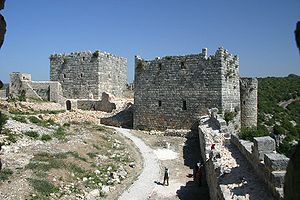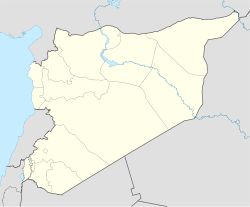- Citadel of Salah Ed-Din
-
Qal'at Salah al-Din
قلعة صلاح الدينNear Latakia, Syria 
Type Castle Coordinates 35°35′45″N 36°03′26″E / 35.595833°N 36.057222°ECoordinates: 35°35′45″N 36°03′26″E / 35.595833°N 36.057222°E Construction
materialsLimestone Current
conditionRuined Open to
the publicYes The Citadel of Salah Ed-Din (Arabic: قلعة صلاح الدين) (Arabic: Qal'at Salah al-Din; once known as Saone, also known as Saladin Castle) is a castle in Syria. It is located c. 30 km east of Latakia, in high mountainous terrain, on a ridge between two deep ravines and surrounded by forest. The site has been fortified since at least the mid 10th century. In 975 the Byzantine Emperor John I Tzimiskes captured the site and it remained under Byzantine control until around 1108. Early in the 12th century the Franks assumed control of the site and it was part of the newly formed Crusader state of the Principality of Antioch. The Crusaders undertook an extensive building programme, giving the castle much of its current appearance. In 1188 it fell to the forces of Saladin after a three-day siege. In 2006, the castles of Qal'at Salah El-Din and Krak des Chevaliers was recognised as a World Heritage Site by UNESCO. The site is owned by the Syrian government.[1]
Contents
History
The Arabic name of the site is Sahyun, the equivalent to Zion. It was later renamed to the politically correct Qal'at Salah al-Din, meaning Saladin's Castle.[2] The site has been fortified since at least the mid-10th century. Byzantine Emperor John I Tzimiskes captured it in 975 from the Aleppan Hamdanid dynasty. It remained under Byzantine control until around 1108 when the Franks took control of Latakia, at which point it is likely they also took possession of Saone. It was part of the Principality of Antioch, one of the four states founded by the Crusaders after the First Crusade captured Jerusalem in 1099. The lords of Saone were amongst the most powerful in Antioch. The first lord of Saone was probably Robert the Leprous and it remained in his family until 1188. It was most likely Robert or his son, William, who built the Crusader castle around the previous Byzantine fortifications.[3] Most of what is evident today was built at this time. The fortress was notable as being one of the few which were not entrusted to the major military orders of the Hospitaller and the Templars.
On 27 July 1188 Saladin and his son, Az-Zahir Ghazi, arrived at Saone with an army and laid siege to the castle. The Muslim forces were adopted two positions outside the castle: Saladin established himself with his siege engines on the plateau opposite the castle's east side while his son was set up facing the north of the castle's lower enclosure. Stones weighing between 50 and 300 kilograms (110 and 660 lb) hurled at the castle for two days, causing significant damage. On 29 July, the order to attack was given. Az-Zahir assaulted the castle town adjoining the castle's west, and the inhabitants sought refuge in the castle. The castle and town were supposed to be separated by a ditch, however at the north end the diggin remained unfinished. Exploiting this, Az-Zahir successfully stormed the castle walls. The inner courtward was overrun and the garrison retreated to the donjon or keep. Before the day ended they agreed terms with their attackers and were allowed to ransom themselves. Though Saone was a strong castle, it fell in just three days. Historian Hugh Kennedy speculates that, though the well-provisioned, this may have been because its garrison was not large enough and they did not have siege engines of their own.[4]
Saladin granted Saone and Bourzey Castle to one of his amirs, Mankawar. The pair descended through his heirs until 1272 when Saone was given to the Mamluk Sultan Baibars. Some time in the 1280s a new amir, Sunqur, was in control and under him the castle became the administrative centre of a "small semi-independent emirate". In 1287 it was captured by the forces of Sultan Qala'un and made a part of the province of Tripoli.[5]
Overview
Saone was built on a ridge some 700 metres (2,300 ft) long between two deep gorges.[3] It guarded the route between Latakia and the city of Antioch.[6] The spur on which the castle is built is connected to a plateau in the east. The Byzantines defended the site by building a wall across the east side of the ridge. The walls created an irregular enclosure and were studded with flanking towers. Adjacent to the fortification, at the eastern end of the ridge was a settlement.[3] One of the most magnificent features of the fortress is the 28 m deep ditch, which was cut into living rock. The creation of the ditch has been attributed to the Byzantines.[7] This ditch, which runs 156 meters along the east side, is 14 to 20 meters wide and has a lonely 28 m high needle to support the drawbridge.
The entrance to the castle is through an entrance on the south side of the fortress. On the right of the entrance is a tower, a bastion built by the Crusaders. There is another a few meters further. There is a cistern for water storage and some stables just next to a massive keep that overlooks the ditch. This keep has walls of 5 m thick and it covers an area of nearly 24 m². Further on to the north is the gate where the drawbridge used to be. Also evident are the Byzantine citadel, located at the center of the fortress, another large cistern, the Crusader tea house, and a Crusader church adjoining one of two Byzantine chapels.
As for the Arab additions to the fortress they include a mosque, which dates back to sultan Qalawun, and a palace, which includes baths with courtyards and iwans. This has been slightly restored.
See also
References
- Notes
- ^ Crac des Chevaliers and Qal’at Salah El-Din, UNESCO, http://whc.unesco.org/en/list/1229, retrieved 2010-11-08
- ^ Kennedy 1994, pp. 84–85
- ^ a b c Kennedy 1994, p. 85
- ^ Kennedy 1994, pp. 95–96
- ^ Kennedy 1994, p. 96
- ^ Molin 2001, p. 85
- ^ Molin 2001, p. 148
- Bibliography
Further reading
- République arabe syrienne (January 2005) (in French) (PDF), Chateaux de Syrie: Dossier de Presentation en vue de l'inscription sur la Liste du Patrimoine Mondial de l'UNESCO, UNESCO, http://whc.unesco.org/uploads/nominations/1229.pdf
- Saade, G. (1968), "Histoire du château de Saladin" (in French), Studi Medievali, 3rd 9: 980–1,016
External links
 World Heritage Sites in Syria
World Heritage Sites in SyriaAncient City of Aleppo · Ancient City of Bosra · Krak des Chevaliers and Qal’at Salah El-Din · Ancient City of Damascus · Palmyra
Categories:- World Heritage Sites in Syria
- Crusader castles
- Castles in Syria
- Aga Khan Trust for Culture projects
- Archaeological sites in Syria
- Latakia Governorate
Wikimedia Foundation. 2010.



